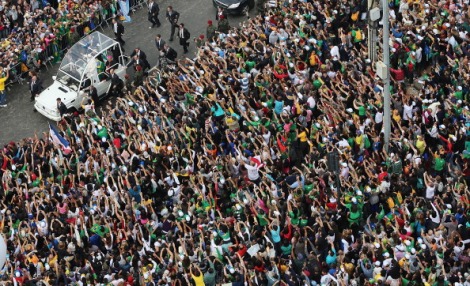It’s clear what’s happening. Hundreds of thousands of middle-aged woman crowding on Rio de Janeiro’s famed Copacabana beach, waiting for hours – some of them days – to catch a glimpse of him. Huge screens have been erected for what seems like miles so his ‘pilgrims’ can see him, even if it isn’t in the flesh. He’s come to the place which, for many of his followers, is arguably the most important place on earth. That’s right: Barry Manilow has finally decided to perform a his eponymous song at the location synonymous with glamour, exuberant wealth and topless women. There are plenty of young people here too, but Mandy and Could It Be Magic are timeless classics.
What’s that? Barry Manilow was booked? Oh, well, did he have any opening acts? Oh, that guy? He was rubbish last time. Oh, really? They’ve got a new guy now? He could be alright, I guess. Well, we’d best bring him on then.
“LADIES AND GENTLEMAN! NOW INTRODUCING IN HIS DEBUT PERFORMANCE, THE WONDERBOY OF THE VATICAN, THE MAN CHOSEN BY GOD, HERE IS…POPE FRANCIS”
But if you were expecting him to perform the usual hits, you would have been sorely disappointed. Rather than classics such as Gays Burn in Hell and Abortion Caution, he performed some stuff more recent in his repertoire. In fact, it was a transition akin to Sgt. Peppers. Anthems which made a solid effort of embracing genuine “social and political concerns”, reaching to young, disenchanted Christians and encouraging Latin Americans to be more than “part-time pilgrims”
It does, of course, make perfect sense that the first Latin American Pope should choose his first large-scale Mass to be held in, well, Latin America. With over 40% of Catholics residing in the region, many of whom still incredibly devout, it could be safe to say that the future of the religions relevance on the world lies well beyond Europe but rather in South and Central America.
But Catholicism, much like in Europe, is falling fast. Statistics suggest that Protestantism, agnosticism and atheism has risen magnificently since the mid-20th Century and young people, put off by a church run by the increasingly out of touch, are growing off the faith altogether. It would seem that the Vatican needs a new image or, some would say, a Jesus-style miracle. Enter Pope Francis.
The man is incredibly likeable. Avoiding the ‘Pope speak’ of demi-Gods past, his audience were enthralled by his all-embracing and extremely relevant words. At a time of social unrest in South America, he was not afraid to call for “Christian” methods to appease and solve the problems. He roamed the streets quite happily engaging in frank conversation with journalists and his flock alike. His self-elected decision to enter one of Rio’s infamous favelas, far removed from the luxurious quarters in Rome, projected the image of a man keen to recognise who today’s Catholics really are; the poor, the meek and humble.
His approach to Latin America’s all important youth was also admirable. The conservative, formal approach of the Church has been a key push-factor for young Catholics, but Pope Francis was not afraid to challenge this almost ingrained tradition. Taking the increasingly active mentality of Latin America’s youth in his stride he called for them to “make a mess” in their dioceses, to “stir things up”.
Like in Europe, the Church in Latin America runs the risk of becoming an institution, a word, rather than the active faith-building religion it was created to be. Pope Francis is keen for this not to happen to his largest flock. The Church shouldn’t become an “NGO” and there must be an end to the self-satisfaction and self-entitlement seemingly common in many of the more devout areas.
The Catholic Church can often be a divisive conversation; years of backwardness and corruption have solidified this. Despite this Catholicism in Latin America is going nowhere, but how it is to be perceived in the future is being decided right now. The Pope’s visit has therefore been vital and, quite rightly, a game changer for the Vatican. Copacabana can be seen as laying the groundwork for some pretty fundamental changes to the Church.
As he left the country he made one of the softest comments about gays in the history of the Catholic Church. Sure, it will be a long time before the Cardinals start performing Elton John tracks during Eucharist or add leather to their cassocks, but it is the start of a slightly more PR-conscious church. And with the magnificent set on the beach, the tweeting and stunts swamped by journalists, creating a new image is what Pope Francis’s new Church is all about.
Picture taken from http://www.kmov.com. I do not own the rights to this photo.

Pingback: 2013: 7 things which have defined Latin America’s year | Watching the Americas·
Pingback: Touchy-Feely: Latin America & the Catholic child abuse scandal | Watching the Americas·